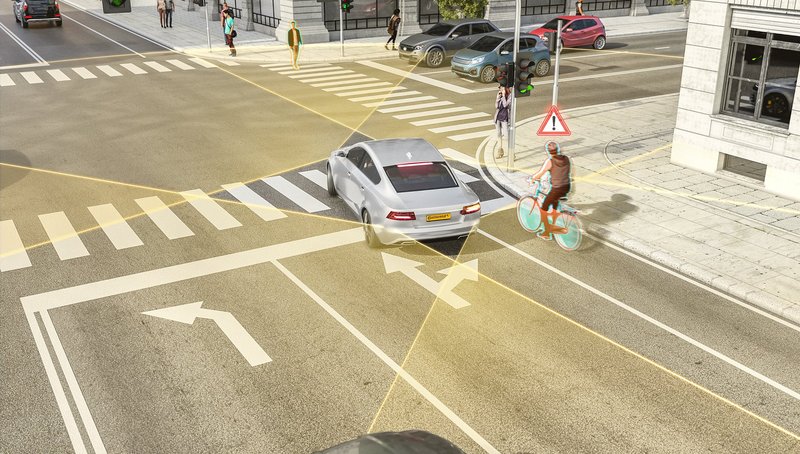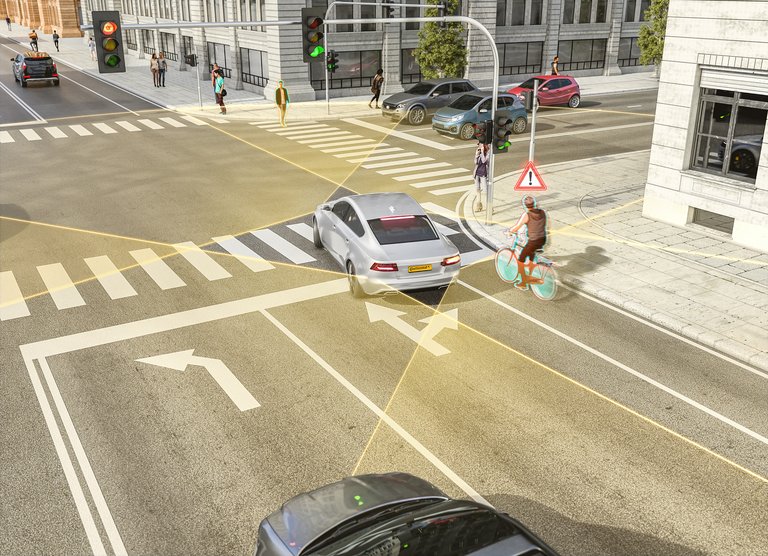Safe Turning: Right-Turn Assist System for Passenger Cars from Continental Protects Cyclists and Pedestrians
- New short-range radar allows for more precise detection of vehicle surroundings
- Technology forms basis for a Right-Turn Assist
- Compact radar system operates within high-resolution 77 Gigahertz range
Frankfurt, Germany, June 25, 2019. Technology company Continental has unveiled a new short-range radar which represents the next development stage towards even more precise detection of the vehicle surroundings. This is a significant leap forward in development. In place of the 24 Gigahertz (GHz) technology used up to now, the new radar generation operates using 77 GHz technology. This means that the radar sensor detects the environment at a much higher resolution and level of accuracy than was previously the case. Consequently, it is able to detect other road users and obstacles much more precisely. Moreover, the 77 GHz sensor also detects movement directions and speeds more precisely than it was possible with the 24 GHz range previously used. In addition, the integration density has been further increased thanks to the new radar generation. As a result, the individual components of the system, such as the antenna and the radio-frequency (RF) chip, are now housed in a smaller installation space, rendering the sensor even more compact. This, in turn, makes it easier to install the system in the vehicle, even in confined places.
New safety functions thanks to even more precise detection of vehicle surroundings
One of the new radar sensors can be positioned at each of the four corners of the vehicle body to ensure almost seamless 360-degree monitoring of the vehicle surroundings. Radar systems such as this already form the basis for various advanced driver assistance systems employing sensors, such as monitoring the blind spots to the left and right of the vehicle in a horizontal direction, detecting the vehicle surroundings for the Lane Change Assist, monitoring cross-traffic and intersections for the Intersection and Emergency Brake Assist systems, as well as monitoring the area behind the vehicle to ensure that vehicle occupants can get out safely. This prevents, for example, the doors from being opened when another vehicle or a cyclist is approaching from behind. Even more functions can now be realized thanks to the much higher resolution and more precise detection offered by the new radar generation from Continental.
These functions include the Right-Turn Assist system for passenger cars, which makes turning-off significantly safer and provides welcome support for car drivers, especially in the confusing situations that sometimes occur in urban traffic. The new generation of radar sensors can detect a cyclist approaching from behind the vehicle on the right-hand side. Right-Turn Assist intervenes if the driver wants to turn right when the cyclist is just about to pass along the right-hand side of the vehicle. Drivers are not always able to recognize this risky situation, even when they look over their shoulders. If the radar sensors detect a cyclist in such a situation, they transmit an appropriate signal to the brakes and the car stops before the car and cyclist collide. Needless to say, this safety function also protects pedestrians and scooter riders.
Less stress for car drivers when turning-off, more safety for cyclists and pedestrians
Right-Turn Assist helps drivers in the often-confusing situation of turning-off to the right, as well as protecting other road users located in the area to the right-hand side of the vehicle. With this assistance system, Continental offers a further technology that will contribute to the realization of Vision Zero, i.e. zero-accident road traffic of the future. Furthermore, this new technology already meets the requirements of the Euro NCAP safety scenarios for 2022 onwards: further improvement in the protection of pedestrians and cyclists. According to an analysis of Continental’s accident research, a Right-Turn Assist system for passenger cars could help prevent five percent of all accidents in which cyclists are killed or seriously injured in Germany and seven percent in Japan (8.5 percent of all accidents involving cyclist fatalities in the US) and a further six percent of accidents in which cyclists suffer minor injuries. The installation of cornering assistance systems in trucks will be mandatory across the EU for all new vehicle types from 2020 onwards. The figures clearly show just how urgent this regulation is. In Germany alone, 36 percent of all accidents in which a cyclist is killed could be prevented by installing Right-Turn Assist systems in trucks.
Emergency Steer Assist system also made possible with new radar technology
The seamless and high-resolution monitoring of the vehicle surroundings made possible by Continental’s new 77 GHz short-range radar technology will form the basis for other advanced driver assistance systems in the future – especially in relation to automated and autonomous driving. Emergency Steer Assist, for example, can be implemented on the basis of data from the new radar generation. In the event of a sudden avoidance maneuver, this system allows the vehicle to be steered away from the collision risk area. Based on the vehicle surroundings as detected by the system, Emergency Steer Assist knows exactly which other road users are in the vicinity, including their trajectories and speeds, and can adjust the steering signals accordingly. This safety system is another component of Vision Zero.

Sören Pinkow
Media Spokesperson Autonomous Mobility and Commercial Vehicles
Continental Automotive


